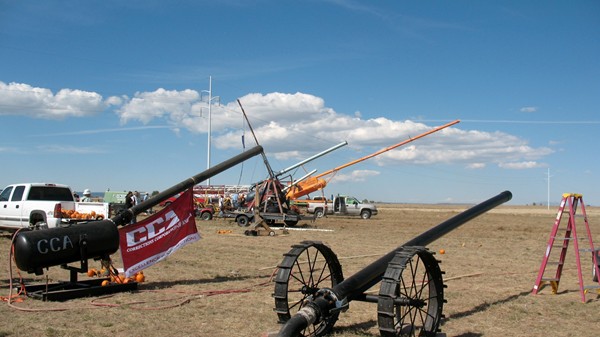Chunking
by wjw on October 18, 2010

So yesterday I took time off from finishing the novel to enjoy a piece of Americana, to-wit: the annual Pumpkin Chunkin’ festival out on the plains of Estancia, NM.
What they do, see, is build these enormous war machines, then shoot vegetables from them.
In addition to vegetable warfare, the festival featured many activities that are traditional in a small-town fiesta, if not actually compulsory. There was an announcer that no one could hear. There were stands selling jewelry, crafts, roasted sweet corn, barbecue, and burritos. There were cowgirls shooting a host of menacing party balloons, and frequently brandishing their weapons in the direction of the audience (though not, so far as I know, actually pulling the trigger when a tourist was in their sights).
There was also a Pumpkin Parade, a pie-eating contest, and the crowning of the Pumpkin Prince and Princess, all of which I missed.
The more successful of the punkin chunkers run on compressed air, and are so powerful that they have to restrain themselves from blowing their ammunition to bits in the barrel, shooting pie filling into the air instead of a pumpkin.
There were two ginormous cannon that resembled the long-range cannon, like the Paris Gun, built by the Germans during the First World War, with barrels so long they had to be supported by wires strung up in a suspension-bridge arrangement. One of these was bright orange and was named El Launcho Grande. The other wasn’t. One of them won the distance competition with a hurl of over 2300 feet— which, even if it won’t hit Paris, is still pretty good considering that pumpkins aren’t exactly the most aerodynamic of projectiles.
After the distance competition, both big guns lowered their barrels to fire on a panel truck parked a few hundred yards away. High-velocity vegetables began the work of turning the truck into scrap metal. A direct hit could really do damage, and even if a round fell short, pumpkin shrapnel could still skip along to dent the exterior and shatter glass.
There were two medium-sized weapons, with barrels twelve or fifteen feet long, that still managed to hurl their projectiles a considerable distance. They participated in a competition to toss a pumpkin through the ring of a used tire, and one of them actually won. I stood directly behind one of these machines, and I could see how the pumpkin changed course in mid-air, flying erratically but always bearing to the left. Was that a high-altitude wind undetectable on the ground, or coreolis force?
It has to be admitted that my heart was more with the traditional chunkers, a couple of trebuchets. One was child-sized, less than six feet tall, and could only hurl its pumpkin fifty feet or so. The other was also smallish (for a trebuchet), with the axle about twelve feet off the ground, and that only because the whole apparatus was mounted on a flatbed trailer. It could hurl a pumpkin maybe 500 feet, at least when it was actually throwing the ammunition in the right direction. In one case, the pumpkin got hung up in the sling and went nowhere; in another, the pumpkin went straight up in the air, and then landed on the machine. (Historically, this sort of thing happened a lot.)
Even though trebuchets were far less efficient at hurling pumpkins than compressed-air cannon, they’re still the weapons you want for after your apres-holocaust vegetable combat— when there’s no fuel remaining for the generators to compress air, and your enemy is hiding behind a rampart of casaba melons, it’s a trebuchet you want to solve that little problem.

I have had a weakness for trebuchets after reading The High Crusade and the nuclear grenade delivery system.
It’s lucky the nuclear grenade didn’t go straight up, then land on the machine.
I, for one, welcome our new vegetable-hurling overlords . . .
If you’re going to take a day off, this is how to do it. Sort of an Artist’s Date thing to renew your creative soul, it is. I approve. Noisy and silly both. But, alas, a waste of good pumpkin, which should be cooked and made into pies and such.
Comments on this entry are closed.